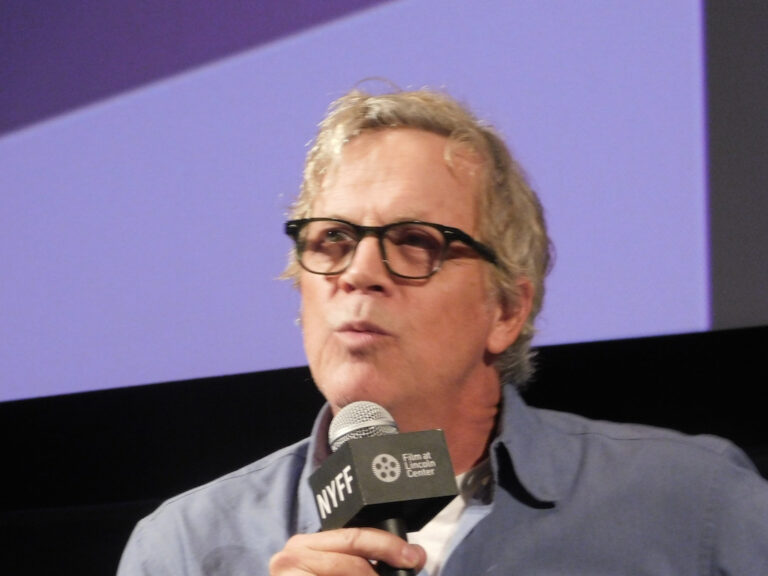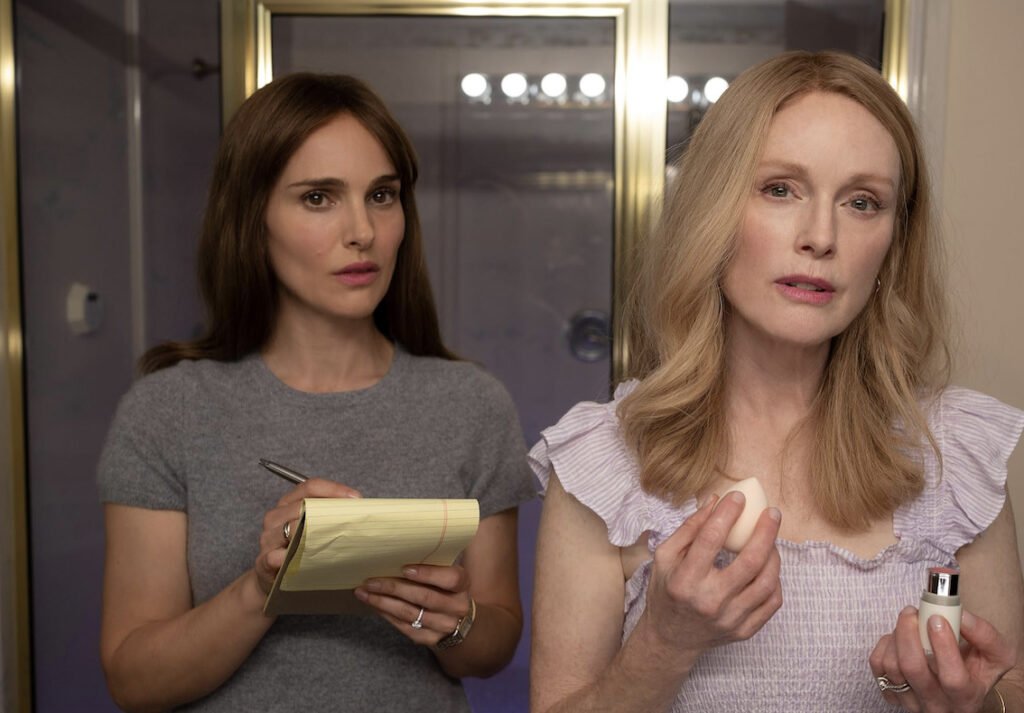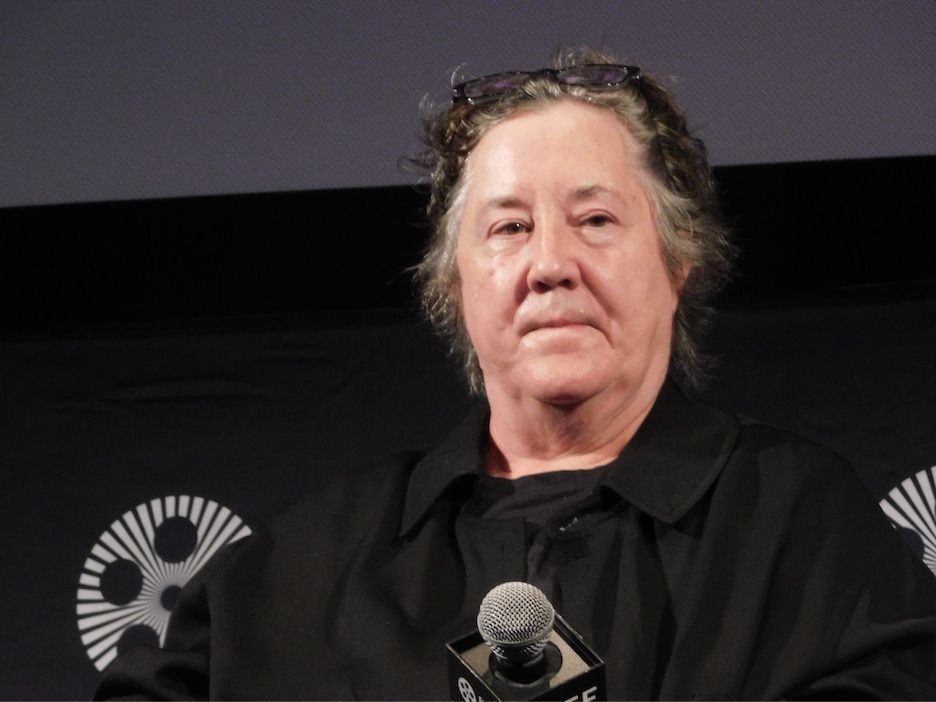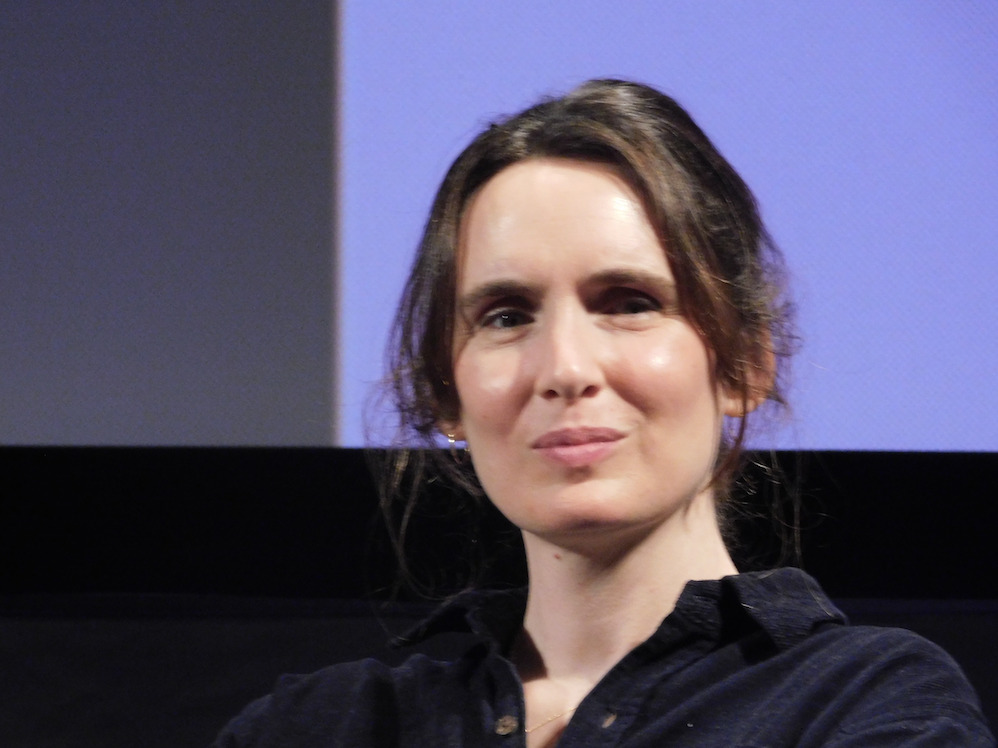
Synopsis : Twenty years after their notorious tabloid romance gripped the nation, Gracie Atherton-Yu and her husband Joe (twenty-three years her junior) brace themselves for their twins to graduate from high school. When Hollywood actress Elizabeth Berry comes to spend time with the family to better understand Gracie, who she will be playing in a film, family dynamics unravel under the pressure of the outside gaze. Joe, never having processed what happened in his youth, starts to confront the reality of life as an empty-nester at thirty-six. And as Elizabeth and Gracie study each other, the similarities and differences between the two women begin to ebb and flow. Set in picturesque and comfortable Camden, Maine, May December is an exploration of truth, storytelling, and the difficulties (or impossibility) of fully understanding another person.
Rating: R (Some Sexual Content|Drug Use|Language|Graphic Nudity)
Genre: Drama, Romance
Original Language: English
Director: Todd Haynes
Producer: Christine Vachon, Pamela Koffler Jessica Elbaum, Sophie Mas, Will Ferrell, Grant S. Johnson, Tyler W. Konney, Natalie Portman
Writer: Samy Burch
Release Date (Theaters): Limited
Release Date (Streaming):
Runtime:
Distributor: Netflix
Production Co: Project Infinity, Gloria Sanchez Productions, MountainA, Killer Films, Taylor & Dodge

Press Conference with Director Director Todd Haynes, Producers Christine Vachon, Pamela Koffler Jessica Elbaum, Sophie Mas, and Screenwriter Samy Burch
Q: Samy, you originated this screenplay before Todd got involved. Is that correct?
Samy Burch: Yeah, that’s correct. I wrote this as a spec [script].
Q: Well, say a bit more about the origin of the screenplay and what interested you originally in this story. It’s so complex and there are so many different amazing layers, strands and moods to the final piece. What was the original spark?
Samy: The original spark was this character of Joe — this idea of a man in the situation being 36 and about to be an empty nester. He is a person who hadn’t really had any time to process what happened to him and the media blitz that followed and the heartbreak of that. That was really the first kind of spark of the idea that made me feel I really wanted to write it.
Q: Jessica [Elbaum], you’re the next piece in this puzzle. Maybe you can talk about how the script came to you and what sparked your interest in it.
Jessica Elbaum: A friend and our agent Blair Cohan sent it to me and said you’ve got to read the script immediately. You’re going to love it as much as I did. I was so drawn to the complexities and remember closing it, not knowing how I felt which I loved so much. Then Will read it and we were like we would love nothing more than to meet Samy and hopefully get the opportunity to work on this with her which we did and then next came Natalie and Sophie.
Q: How did that happen?
Sophie Mas: Jess sent it to us and we really loved it at first sight. It was a very unique, original script. We rarely read something this good. Natalie talked with Jess and thought that we needed to have an incredible director. Natalie thought of Todd, so she sent it to Todd. That’s how Todd and Killer then joined the team.

Q: Todd and Pamela [producer, Killer Films], It’s unusual for you to come to a project this way. Someone sends you a script you didn’t originate. Can you talk a bit about that and what your thoughts were in deciding that this was something you wanted to take on.
Todd Haynes: It actually started a long while ago with the script of “Carol.” The whole project of “Carol” — based on Patricia Highsmith’s novel “The Price of Salt” — had been kicking around for almost 20 years in development and that was a project that came to us through very close friends of ours who had inherited it as producers in the UK. Before that I had adapted — this was just my own decision with my writing partner Jon Raymond — “Mildred Pierce” from the James M. Cain’s novel and that was my first episodic production made for the small screen. I’ve been moving in the direction of trying out different methods of how to find material, and, of course, for the films I’ve written and developed myself.
The research often comes from other sources and there are ways of interpreting the histories around artists and musicians and/or works by filmmakers like Douglas Sirk. I’ve always felt like I’ve been an interpreter of existing languages in film and in culture. “Wonderstruck” and “Dark Waters” were scripts that came to me. The Velvet Underground documentary, which I had done last year, was suggested for me to do. Again, it was a completely new territory for me, an extraordinary thing to work on and play with. We were cutting it at the height of Covid when this script [for “May December”] came to me. A lot of scripts were circulating during Covid because everything was shut down and everybody was speculating on what to do next.
Natalie [Portman] and I had discussed other projects in the past so there was an interest on both our parts to try to find something that we could do together. But this script was something else and left an impression on me that stayed with me. We started to talk about it right away. Natalie and I shared notes and then talked to Samy remotely, of course. The whole way the film got turned into a real production happened very quickly and with a lot of moving parts suddenly opening up and aligning in brief moments of freedom for me and the two actors that we jumped on last year.
Q: Pamela, you can talk about some of those quickly moving parts. Was there anything especially urgent or surprising as to how you decided where to shoot?
Pamela Koffler: The location was a big inflection point. Samy’s original script was set in Camden, Maine, and, of course, the pragmatists that we are said, “There’s no tax credit in Maine so a movie like this — which is made 100% independently — needed to consider that.”
Todd Haynes: And it had to be set in May. We couldn’t do it in the fall when we were all free.
Pamela Koffler: When Todd gets his fingerprints all over something all kinds of creative values or something start to immediately emerge. Savannah, Georgia, became a great idea and we sent Todd and his team down there. They fell in love with the place and we built the production plan around being able to shoot there. That was one of those moments where we’re like okay we locked in a plan now we just got to move to grab the actresses availability.
Christine Vachon [producer, Killer Films]: But it was really over the Fourth of July weekend where we began trying to figure out how to fit the movie into Natalie and Julianne’s schedule at the very end of the year and what kind of compromises would be brought in in terms of weather. We literally were sitting there going, “How long will the leaves on the trees in Savannah be and who can tell us for sure about all of these things.” There was a giant schedule change for Julianne and that flipped everything back around literally from one day to the next but we got what we wanted.

Q: This film functions on so many different levels and somehow they all manage to be in perfect harmony. Can you talk about some of those different moods that the film is playing with the resonance between those different moods.
Todd Haynes: It started on the page with this dedicated sense of discomfiture that Samy protected in the writing — a slight distance and refusal to form moral opinions about the characters or redeem either of the female characters in the course of the film. I loved that, Natalie loved that and when we shared it with Julianne, she loved that. For me, the task was to try to find a visual and stylistic language and a series of tonal decisions that would give the viewer a comparable place to interrogate what they were watching. I also felt it was really important because I felt that on the page and really love that about it.
There was an element of pleasure in doing so [that] it made you uncomfortable but there was an excitement about interrogating yourself as you read it. I wanted that to be an experience for the viewer and so there were just a few things — and I don’t know how much we want to get into all that stuff now — but there were a few decisions that helped me to start to set in place some tonal ideas. It had to do with the music, it had to do with a very restrained camera and it had to do with looking at movies that I immediately thought of like films by [Ingmar] Bergman, in particular “Persona.” But bringing to all of that a different kind of mischief. I think in the way the audience might be able to navigate it.
Q: Could you dig in a little more to those decisions you made?
Todd Haynes: Like I said, when I read the script, we talked about some of this so it’ll be fun to finally have [Samy] on board with us. And this is a very exciting day for us so to have Samy with us, it helps us a little bit with the grief of not having the actors with us but I read that monologue of Elizabeth [Yu, who plays Mary Atherton-Yoo] towards the end of the movie and I immediately thought of the scene in Ingmar Bergman’s “Winter Light,” where Ingrid Thulin delivers a letter to the lens of the camera — the film is shot in black and white– in a medium shot against a neutral background.
I remember seeing it when I was in high school and being completely riveted by the performance. It’s an unrequited love letter to a priest character in the movie. It was the simplicity and austerity of the shot that made such an impact. I thought, “I have to do this movie, if only to shoot that monologue that way.” What would be the tonal language that would make that work and have that be meaningful. Of course, there are all these scenes in mirrors and it’s about an actor studying a subject and learning how to become and interpolate and internalize that subject. It’s that strange and creepy process that goes on between the merging of the two women.
Of course. “Persona” is another seminal urtext for the female merging/mirroring story. There are moments — even though they are not necessarily played as mirrors — where the two women ultimately do turn their gaze to the lens of the camera. Bibi Andersson or Liv Ullmann, I can’t remember who because they’ve already blurred by this point, brushes the hair slightly off the forehead of the other. These were ideas that also circulated in the film. Around this time last year, the movie “The Go-Between” by Joseph Losey from 1971, played on Turner Classic Movies.
It’s a film I remember having seen when I was a kid, but it had fallen out of circulation and I hadn’t seen it in so long. The score in that film by Michel Legrand is an astonishment. It slaps you in the face! From the very first opening credits of the movie, you are on alert in the most exciting way. It’s a pastoral coming-of-age story of a boy who goes to his rich brother’s family’s country house for the summer and develops an infatuation with his beautiful sister Julie Christie and so forth. In a way, the score feels almost more outside the eventual plot of “The Go-Between” and the complicated moral background of this story.
But I loved how it put the viewer in a state of active reading of the film — a sort of mysterious, ominous, investigatory state. Almost like the one Elizabeth undertakes as an actor. So we worked with this music. We used it in preproduction of the movie, we used it while shooting the movie and we used it while cutting the film. Until, finally, I came to Marcelo Zarvos, my composer, and said, “I think we got to try and use this music, man!” It’s baked into the DNA of the film and the way the film seems to be working. Then he made it his own. Marcelo arranged the entire score and wrote original music for it. Then we re-recorded it all from scratch. I have the amazing Marcelo Zarvos score but I also was able to retain the powerful signature from Michel Legrand.

Q: Samy, since Todd keeps saying that all these different levels were in the original screenplay, did you have similar touchstones in terms of how you were thinking about those moods while you were writing the original screenplay?
Samy Burch: I really liked the tonal mix of humor and genuine sadness and heartbreak. I feel like some of the humor is intentionally so uncomfortable that it breaks the tension that’s needed and then some. I don’t know, maybe the acerbic dealing with this actress coming to town and the Hollywood Machine of it and the satire of that. But that’s what I am interested in as a viewer.
Q: How did you approach seeking truth in this film and its fuzzy, murky qualities?
Todd Haynes: I don’t know if I ever do seek truth in the film where, if ever, the film is truly enlisted to provide it. I think more questions are raised about how we go about the industry of making truth, who is enlisted in that process, and how partial is the vision. This notion of how precious a vision of that is, how much we all think, “Oh yeah man, the truth, yeah let’s all get there.” But really, the questions behind that are really important ones and there’s something really curious that goes on in the power dynamic between these two female characters. One comes with all of this privilege and power from the Hollywood machine.
These notions of truth that we all nod to benignly and who seems to be investigating and finding it, search at any cost to the point where we’re like, “Wait a minute she went that far.” You know where her limits are. Of course, you’re comparing the two women throughout the film but there’s a character in Gracie who is a source of resolute survival and is quite articulate and outspoken. “I’m not insecure, meaning, I don’t question anything that I’ve done.” At least that’s the armor that she holds up, so when you think that the person who has all the power and is knocking down the lies and getting to the truth is the one who ultimately is going to, quote unquote, win you [over] will ultimately see how that sense of refusal to look at things [presents] a contrary power against the former/other person…
All of this you’re negotiating in your head as you watch the film and as you read it… But none of it would have been made possible without the sort of collateral damage of Elizabeth’s breaking through. None of this would have enabled Joe [Yoo, played by Charles Melton] to have the potential of looking at himself in ways that were just not allowed for all these years. That’s clearly — as Samy has described — the character with whom we feel the most hope. We look at the kids with hope; there’s a chance that some of these folks are going to survive this. I think part of it is the contradiction or the, you know, dialectic of this Truth Versus Resistance.

Q: Obviously, it’s a work of fiction but people will compare this to the real life story of Mary Kay Letourneau. Did you research that case at all when writing this? When did you start writing it?
Samy: I started writing it in 2019 and I really, really wanted a fictional story that dealt with this tabloid culture of the ‘90s that has seemingly bled into this true crime biopic world we’re in right now. It kind of questions that transition and why we want to keep recreating these stories. I think that that was the real jumping off point for me.
Q: Did you follow the Mary Kay Letourneau case when it was happening? You seem too young for that though…
Samy: I’m a baby, so I actually don’t know what you’re talking about? all of these stories like this are in The Ether. They are just completely embedded in everyone’s cultural history.
Q: You created the most fascinating lisp in film history. This performance shows how it comes and goes and moves from one to the other. Please talk about the lisp.
Todd Haynes: I didn’t create the lisp. There are some people who are missing today who could speak so beautifully about how they built these characters. We shot this movie in 23 days in Savannah with very limited resources. That meant there was no rehearsal time. The schedule was unusually short, but the fact that there was no rehearsal time isn’t unusual in the films I’ve made. It meant that the burden was on Julianne Moore to completely come up with the specificity of Gracie. We started shooting the house scenes right away.
Things like the wigs — which had to be made in advance — were decisions which had been very much a part of planning and discussing and all that. The way Elizabeth’s hair would change a little in style to match the Gracie wig — they both were wigs. Down to the cadence and her manner of speech — these were late [in the process]. These were issues that Julianne and I talked about and yes, there were things in a kind of loose upper palate that we did find interesting in Mary Kay Letourneau’s speech. That was a kick-off for her. She took it further. Also, this idea of how does this kind of original relationship occur? What is the myth these two people tell each other about the roles they’re playing?
This woman is not a pedophile. She didn’t have a history of going after every little teenage boy that walks by. There’s something very specific that happened to these two people, but it’s shrouded in a fantasy. Which is — she is the princess that needs to be rescued from the domestic tower. He’s the young virile knight — almost like a Greco-Roman young knight — who’s going to come in with all this sexual virility, power and beauty — and save her. She plays the little girl. It inspired aspects of the clothes, the manner of speech and the color palette. All these things helped us to understand how this happened or the delusions that helped produce it.
Check out more of Nobuhiro’s articles.
Here’s the trailer of the film.


[…] suggesting she was too young to remember the 1997 scandal. "I'm a baby," she cheekily responded, before adding, "All of these stories like this are in The Ether. They are just completely embedded in everyone's […]